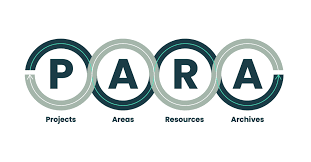The business world is constantly changing so managing knowledge effectively is paramount. One of the tools gaining traction for this purpose is the Notion platform, a powerful tool that can organize, store, and share information. But how do we optimize this tool for a collective, organizational level? The answer lies in adapting the Second Brain methodology for collective use, using PARA (Projects, Areas, Resources, Archives) and CODE (Collect, Organize, Distill, Express) methodologies.
The Building a Second Brain Methodology
Building a Second Brain (BASB) is a methodology designed by productivity expert Tiago Forte. The concept is built on the idea of extending your organic brain’s capacity by creating an external, digital space to store and manage your ideas, information, and knowledge. This ‘second brain’ can be thought of as an extension of your mental space, a repository where you can offload information, freeing up cognitive capacity for more complex and creative tasks. The central tenets of the BASB method are the PARA and CODE systems, which are essential for organizing and managing the information stored in your second brain.
Implementing Building a Second Brain in a Collective Environment
The transition from individual to collective implementation of the BASB methodology presents an exciting opportunity for organizations. To do this, the concept of a ‘second brain’ has to be expanded from a personal knowledge management system to a shared, collaborative knowledge base that benefits the entire organization.
The PARA and CODE systems still form the backbone of the methodology, but the approach to them becomes more collaborative. For instance, the ‘Projects’ in PARA would represent the active projects within the organization, with each team member contributing their ideas and information. Similarly, the CODE system would involve the collective effort of the team — everyone contributes to collecting, organizing, distilling, and expressing the information.
This collective approach allows for a richer, more diverse pool of knowledge and ideas, as it incorporates the perspectives and insights of a variety of individuals. It also fosters a culture of shared responsibility and collaboration, as everyone is involved in managing and contributing to the organization’s collective ‘second brain’.
It’s important to note that this transition requires careful planning and management to ensure that the system remains organized and efficient. However, when implemented correctly, a collective ‘second brain’ can significantly enhance an organization’s knowledge management, innovation, and overall productivity.
Implementing PARA

1️⃣ Projects (P): A dedicated space for all active projects within the company is crucial for effective knowledge management. Each project should have its own page on Notion, where the team can record and update all necessary information. This makes it easy for everyone to keep track of ongoing initiatives and their progress.
2️⃣ Areas (A): Each key area of the business, such as sales, finance, marketing, operations, etc., should have its own page as well. This allows for specific, relevant knowledge, updates, and ideas to be shared and accessed by the team.
3️⃣ Resources (R): This is a space dedicated to all the company’s areas of interest and items that can be useful to the team. It might include templates, guides, tutorials, and more. It’s all about facilitating access, saving time, and creating a fertile ground for future product ideas. The cross-pollination of interests across the team can lead to the germination of new product concepts.
4️⃣ Archives (A): Lastly, it’s important to have a place for inactive information or everything that doesn’t fit into the categories above. These might be reference files or documents that aren’t actively needed but could become useful at some point.
Integrating CODE

Once the PARA structure is in place, it’s time to implement the CODE methodology.
Collect (C ): The first step is to direct all content produced in the company to a central inbox within Notion. This could include documents, meeting notes, ideas — anything that holds potential value for the company.
Organize (O): Next, this collected content is sorted and placed into the appropriate PARA category. This stage is crucial for maintaining order and ensuring that information can be easily located when needed.
Distill (D): This is where the real magic happens. Information is transformed into something usable and actionable. It might be a summary, a list of actions, or a project plan. The distillation process is open to everyone, fostering an environment of collective knowledge creation.
Express (E): Finally, the distilled information is shared with the team in the most efficient way possible. This could be in a team meeting, an email, or a note within Notion. The aim is to keep the entire team updated and on the same page.
The integration of the PARA and CODE methodologies in Notion can revolutionize the way an organization manages its knowledge. It’s a dynamic, flexible, and inclusive approach that encourages collective contribution and participation. The journey may be challenging, but the reward — a well-structured, efficient knowledge management system — is certainly worth the effort.
Forte, Tiago. 2022. Building a Second Brain. New York: Atria’s Books.